Let's go through every element of what's included in the technical SEO audit service and talk why each part is important.
In this section of the audit, we’re checking the sitemap of the website. We’re looking for any pages that might need to be added to the sitemap as well as odd errors such as URLs in the sitemap that might not be indexable.
Making sure the sitemap is (relatively) error free is an important process.
While a few errors won’t be much of an issue, but many should be taken care of.
We're going to list each error individually so you know exactly what and where to fix it.
Naturally, you’ll want to take care of any broken links on the website, whether they’re pointing to an internal URL or an external link out.
We're also going to check the entire site to look at what's being blocked from indexing on the site. If there are any URLs being blocked by Robots.txt, you'll want to give a look at these URLs to make sure you really want them blocked.
Furthermore, we look for odd errors like redirect chains. These can slow the site down, so it's important reduce the amount of redirects if possible and fix any redirect chains if they're found.
We're looking at a few different elements in this section: orphan URLs, pages with a high crawl depth, and anything else that might be affecting crawlability of the website itself.
Orphan URLs won’t be crawled by Google because they won’t be found by the spider (unless they’re found in the sitemap). You'll need to make sure you internally link to any orphan URLs, if you want them to be found.
The most important part of this section is the high crawl depth pages. Look for pages in here that are important but have a high crawl depth. Reducing the crawl depth on these pages can help improve rankings and is easy to do. You'll just have to take a look at what's going on with the site's internal link architecture and how it can be improved.
The image audit is relatively straightforward.
You might find images in this section that are too big (such as 1mb or more). Get these compressed.
Furthermore, setting proper alt tags is good for image SEO, if that’s important to you.
The Schema audit is something you should pay close attention to. Structured data can give search engines explicit information about the pages or business itself. I think it's a huge mistake to ignore schema (if you've been doing that).
For the audit, we're going to look at the schema itself on each page. URLs with validation warnings and schema errors can be debugged using tools like the Schema Markup Validator and the Schema Markup Testing Tool.
Try to have a clean, comprehensive, and error-free schema on as many pages as you can.
While we don't test site speed comprehensively, we do give a rough overview of the sitespeed using the GTmetrix tool.
It’s my favorite site speed testing tool by far because not only will it give you a performance grade, but it will also give you a little checklist on what you can do to improve this grade.
While it's almost redundant, the Technical SEO Audit wouldn’t be complete if we didn't check for this.
Chances are the website already has SSL installed, but we have to check for it here.
The audit gives a rough check of any hacks or if the site has been hacked.
We give a look at your outgoing links and if any malicious pages might have been indexed, along with some other things that might be affecting the site negatively.
Unfortunately, hacks are getting more common these days and can have a huge detrimental effect on rankings if you’ve been targeted.
I'm going to share a part of what the final report looks like when we complete these for clients.
Below you'll find a link to the individual URL data sheet. It's a tab separated template that you can easily copy, customize, and use for your own projects, if you like:
Download template!
(reported data shown in this audit template is just dummy data - your audit may look similar)
For each order, the spreadsheet will come along with a final written report. This is a 2+ page overview document that gives a little more insight into what's going on with the site itself.
You'll have a good bird's eye view into where you should take the next steps into improving the technical SEO of the site and exactly what URLs you should be focusing your energy on.
In my opinion, that's what a good audit should do: give you some sense of direction into what is usually cloudy and confusing.